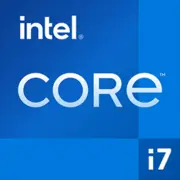Intel Core i7-1355U

Intel Core i7-1355U:2025年ウルトラブックにおけるパワーとモビリティのバランス
2025年3月
はじめに
現代のノートパソコンは、プロセッサーに高いパフォーマンスだけでなく、エネルギー効率も求めています。Intel Core i7-1355UはRaptor Lakeシリーズの一環として登場し、仕事、創造性、モビリティを求めるユーザーの要望に応えるための汎用チップとなりました。本稿では、その特長、適したユーザー、注意すべきポイントについて詳しく見ていきます。
1. アーキテクチャと製造プロセス:ハイブリッドコアと統合グラフィックス
Raptor Lakeのハイブリッド構造
Core i7-1355Uは、Intel 7プロセス(10nm Enhanced SuperFin相当)を使用したRaptor Lakeアーキテクチャに基づいています。このチップは以下を統合しています:
- 10コア:2つのパフォーマンスコア(P-cores)と8つの効率コア(E-cores)。
- 12スレッド:P-coresはデュアルスレッド動作、E-coresはシングルスレッド動作。
- クロック周波数:ベース1.7GHz、Turbo Boostで最大5.0GHz(P-cores用)。
Intel Thread Director
この技術は、コア間のタスク配分を最適化します。たとえば、重いアプリケーション(動画編集ソフト)はP-coresに負荷をかけ、バックグラウンドプロセス(メッセンジャー)はE-coresに振り分けられます。これによりエネルギー消費と発熱が抑制されます。
統合グラフィックスIris Xe
iGPU Iris Xeは96のEU(実行ユニット)を搭載し、以下をサポートします:
- HDMI 2.1またはThunderbolt 4を介した4Kディスプレイ。
- XeSS(ゲーム用のアップスケーリング)およびQuick Sync(ビデオエンコーディングの加速)。
- 低設定でのゲーム:Fortnite(1080pで60 FPS)、CS2(70-80 FPS)。
メモリとインターフェース
- DDR5-5200およびLPDDR5-6400をサポート。
- 最大64GBのRAM。
2. TDP 15W:実際の動作はどうか
TDPとは何か?
熱設計電力(15W)は、基本的なシナリオにおける平均的な電力消費を示します。ただし、ターボモードでは、チップが一時的に55Wまで消費することがあります。
動的電力管理
- アイドル状態では、クロック周波数が800MHzに低下し、電力消費が3-5Wに抑えられます。
- 負荷がかかると(例えば、ビデオレンダリング時)、ターボブーストが有効になり、冷却システムは熱を処理する必要があります。
アドバイス:BIOS設定で「サイレント」モードを選択し、パフォーマンスを若干落とすことでファンの騒音を軽減します。
3. パフォーマンス:オフィスから軽いゲームまで
オフィス作業
- Chromeで30以上のタブ、Microsoft Teams、およびExcelをスムーズに実行。
- PCMark 10テスト:5800ポイント(i7-1255Uより15%向上)。
マルチメディア
- HandBrakeでの4Kビデオ変換:10分の映像を4.5分で処理(すべてのコアを使用)。
- Adobe Photoshop:フィルターやレイヤーがほぼ瞬時に適用される。
ゲーム
- Genshin Impact: 720pで40-45 FPS(低設定)。
- Cyberpunk 2077: XeSSのパフォーマンスモードで25-30 FPS。
ターボブースト:長所と短所
- Cinebench R23ベンチマークで、シングルスレッド1580ポイントおよびマルチスレッド7508ポイントを記録。
- ただし、薄型筐体(例:ASUS ZenBook 13)では、5-7分の負荷後に熱によるスロットリングが発生する可能性があります。
4. 使用シナリオ:i7-1355Uは誰に適しているか?
- 学生やオフィスワーカー:マルチタスク、文書作成、およびビデオ会議。
- フリーランサー:DaVinci Resolveでの短いビデオ編集、写真処理。
- 旅行者:1.2kg以上のコンパクトなウルトラブック。
不適合:
- アルティメット設定を求めるゲーマー。
- SolidWorksで3Dモデルを扱うエンジニア。
5. バッテリー寿命:作業時間最大10時間と省エネ技術
実際のテスト:
- ウェブサーフィン(明るさ150ニト):9-10時間。
- Netflix視聴:7-8時間。
- 負荷時(レンダリング):2.5-3時間。
エネルギー効率技術:
- Intel Dynamic Tuning 3.0:負荷に応じてパワーを適応的に調整。
- Connected Standby:スリープモードからの瞬時復帰。
アドバイス:タスクマネージャーでバックグラウンドアプリを無効にし、OLEDディスプレイでバッテリーを節約するためにダークテーマを使用しましょう。
6. 競合製品との比較
AMD Ryzen 7 7840U:
- 長所:より優れたマルチスレッド性能(8つのZen 4コア)、ターボモードを長時間維持。
- 短所:DirectX 12での統合グラフィックスRadeon 780Mが劣る。
Apple M3(MacBook Air向け):
- 長所:最大18時間のバッテリー寿命、冷却性能。
- 短所:Windowsアプリとの互換性が限られている。
Intel Core i7-1255U(前世代):
- i7-1355Uは追加のE-coresによりマルチスレッド性能が20%向上。
7. プロセッサーの長所と短所
強み:
- ウルトラブックに最適:コンパクトなフォームファクターでのパワー。
- Thunderbolt 4およびWi-Fi 6Eのサポート。
- 要求の少ないゲーム用に良好なグラフィックス。
弱み:
- 薄型筐体での発熱。
- Apple M3に対するバッテリー寿命の劣位。
8. i7-1355U搭載ノートパソコンの選び方
デバイスタイプ:
- ウルトラブック:Dell XPS 13($1299から)、Lenovo Yoga Slim 7。
- ビジネスノートパソコン:HP EliteBook 840 G10(耐久性のある筐体)。
注目すべき点:
- 冷却性能:デュアルファンシステムが望ましい。
- ディスプレイ:解像度はFull HD以上、明るさ300ニト以上。
- メモリ:最低16GBのLPDDR5。
避けるべき点:パッシブ冷却のノートパソコンはプロセッサーの性能を発揮できません。
9. 最終結論
Intel Core i7-1355Uは、パフォーマンスとポータビリティのバランスを求める人にとって素晴らしい選択です。これに適しています:
- 移動中や自宅での作業。
- 軽いクリエイティブ作業や学習。
- Thunderbolt 4や最新のインターフェースを重視するユーザー。
主な利点:
- 薄型筐体のハイブリッドアーキテクチャのパワー。
- DDR5やAI最適化による将来のタスクへの準備。
もし予算が$1200-1500で、バッテリー寿命と引き換えに速度を犠牲にしたくない場合、i7-1355Uは信頼できるパートナーとなるでしょう。しかし、ゲームや複雑な3DモデリングにはディスクリートGPUを搭載したノートパソコンを検討した方が良いでしょう。
基本
CPUの仕様
メモリ仕様
GPUの仕様
その他
ベンチマーク
他のCPUとの比較
ソーシャルメディアで共有する
または当サイトへのリンクを追加
<a href="https://cputronic.com/ja/cpu/intel-core-i7-1355u" target="_blank">Intel Core i7-1355U</a>